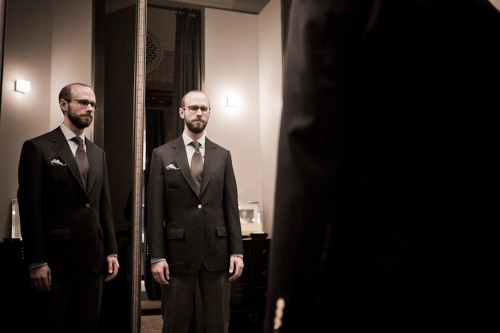Pete, Hong Kong: When I’m standing in front of the mirror for my first fitting, how do I tell whether the suit fits or not? How do I know if the tailor has done a good job, and tell him to change something if he hasn’t?
As with the last post, here is a list of areas to examine. Check these things at the first fitting and the second. In fact, check them every time you put the suit on, as the tailor will probably be willing to change one or two things shortly after the suit is done. And it probably won’t cost much to change them long after the fact.
These tips equally apply to a ready-to-wear suit, and can help you decide which aspects of the suit to have altered.
All of these points are subject to personal taste and fashion. This is a description of the fit of a classic suit worn to today’s tastes. Its closest historical archetype is probably the Drape.
Shoulders: If the shoulders are too narrow for you, you will see the swell of your actual shoulder pushing against the material at the top of the sleeve. There may also be stretch lines running across the material and an indentation at the top of the sleeve. These lines can also be a sign that the sleeve is too narrow for you.
If the suit is too big, its shoulders will extend in a ledge beyond your own. To fit properly, there should be a clean, direct line from the edge of the suit’s shoulder to the edge of yours, just skirting the skin.
Collar: The collar of the suit, at the back of your neck, should sit flush with the collar of your shirt, leaving between one and two inches of shirt above the suit (depending on the height of your collar). If there is too much material across the back, the collar will stand away from your neck. If there is too little, the collar will be flush with your shirt and there will be folds running horizontally below the collar where the cloth is stretched.
(Tip: When being measured, don’t stand up artificially straight and tall. It may impress the tailor, but all your suit collars will stand away from your neck when you stand naturally.)
If you can, get two or three mirrors to look at yourself in. It is particularly useful if you can see your back – it is a roadmap of fit. The folds under the collar are mentioned here, but you will also be able to see unsightly stretch marks across your tummy if it is too tight there; if there are wrinkles underneath your arms this probably means the shoulders are sagging; and one long fold down the middle of your back demonstrates an excess of material there. It’s all pretty intuitive – just look for those wrinkles and wonder what they might mean.
Waist: The fit of the waist is very much a matter of personal taste, but there should definitely be an obvious suppression in the line of suit at your side, going in where your waist button fastens (middle button on a three-button suit, top one on a two-button). There should be no folds radiating from the waist button, which again show the cloth being stretched. And when you pull the waist button away from you, it should pull out easily an inch or two, but no more.
Beyond that, try walking around the fitting room and moving your arms. The jacket should feel comfortable (this will be helped by higher armholes). It should of course be unbuttoned when you sit down – but try doing this and make sure you would be comfortable typing at a desk when seated.
Most other aspects of fit were mentioned in my previous posting – sleeve length, trouser length etc. Add these to the checklist above.
Hopefully, you should be a relatively good judge of whether your trousers fit you around the waist.




























